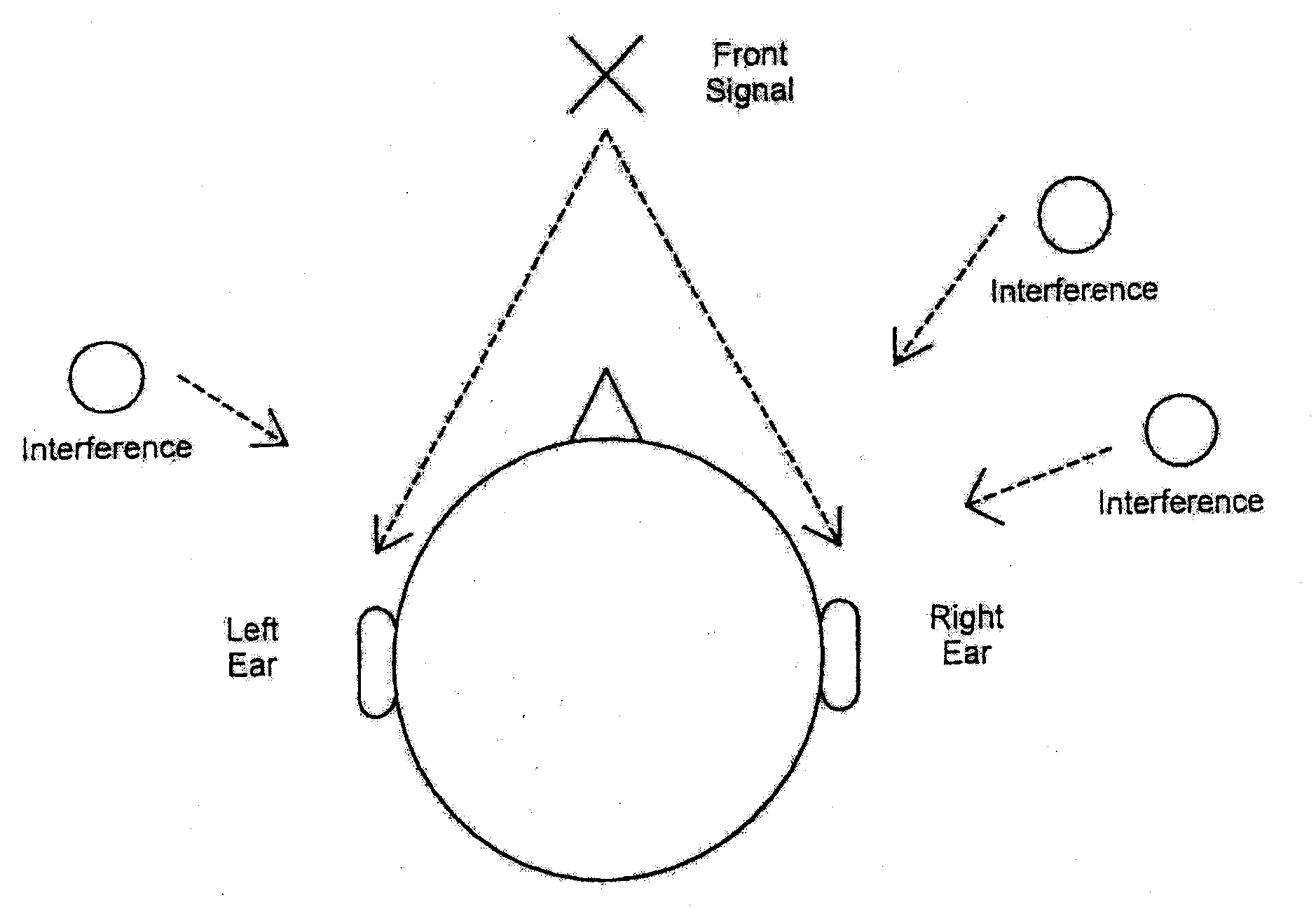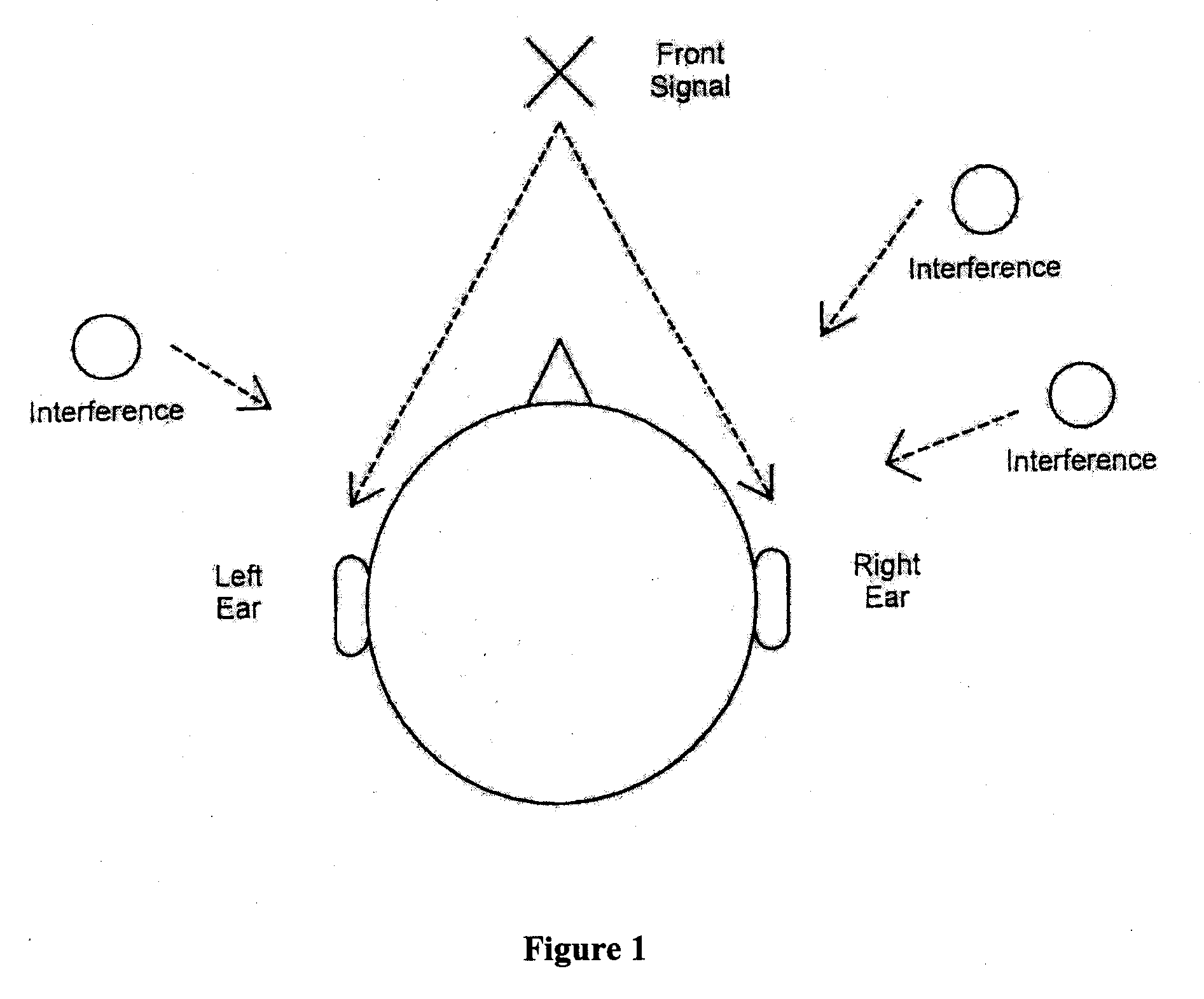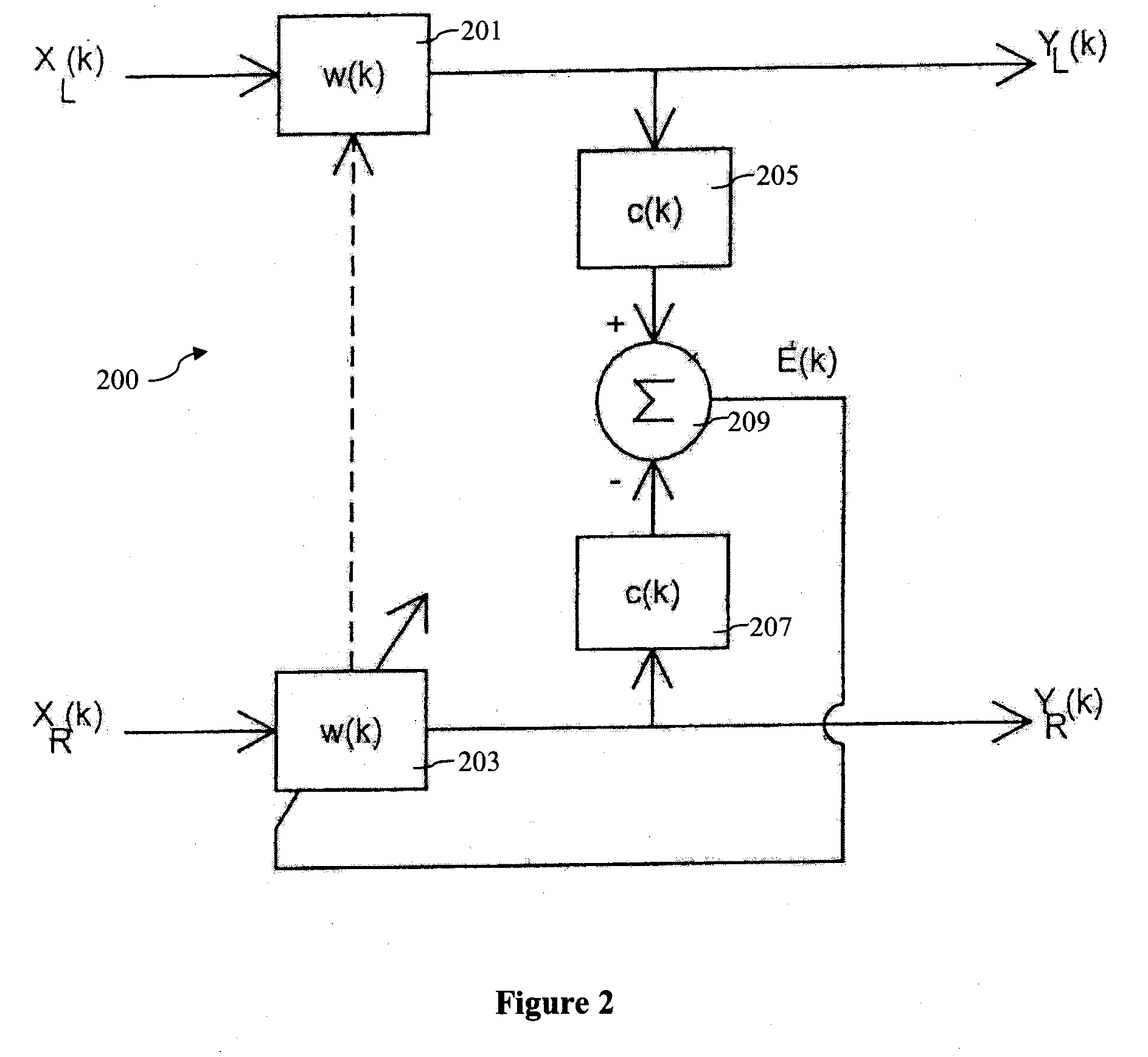[0022]A signal processing system, such as a hearing aid system, adapted to enhance binaural input signals is provided. The signal processing system is essentially a system with a first signal channel having a first filter and a second signal channel having a second filter for processing first and second channel inputs and producing first and second channel outputs, respectively. Filter coefficients of at least one of the first and second filters are adjusted to minimize the difference between the first channel input and the second channel input in producing the first and second channel outputs. The
resultant signal match processing gives broader regions of signal suppression than using the Wiener filters alone for frequency regions where the interaural correlation is low, and may be more effective in reducing the effects of interference on the desired speech signal. Modifications to the algorithms can be made to accommodate
sound sources located to the sides as well as the front of the listener.
Processing artifacts can be reduced by using longer averaging time constants for estimating the signal power and cross-spectra as the signal-to-noise ratio decreases. A stability constant can also be incorporated in the transfer functions of the filters to increase the stability of the signal processing system.
[0023]Thus, in one aspect, the invention is a multi-channel signal processing system, such as used in a hearing aid system, that is capable of processing signals binaurally. The signal processing system comprises a first signal channel with a first filter and a second signal channel with a second filter. The first filter processes a first channel input to produce a first channel output, and the second filter processes a second channel input to produce a second channel output. Transfer functions of the first and second filters operate to minimize a difference between the first channel input and the second channel input when producing the first channel output and the second channel output, respectively. In a preferred embodiment, the transfer functions of the first and second filters are identical. In another embodiment, the transfer functions are different. In the preferred embodiment, the difference minimized is a normalized difference between the first and second channel inputs and at least one of the filters adjusts its filter coefficients to minimize the difference in producing the first or second channel output. According to the preferred embodiment, the normalized difference is defined asP(k)=X1(k)2+X2(k)2,where X1(k) and X2 (k) are the first and second channel inputs for the frequency bin having an index k, respectively, and angle brackets denote averages of equation results inside the angle brackets. In another preferred embodiment, the normalized difference is defined asP(k)=N(k)2S(k)2+N(k)2,where S(k) and N(k) are a signal spectrum and a
noise spectrum for the frequency bin having the index k, respectively. In yet another preferred embodiment, the signal processing system further comprises a first cost function filter, a second cost function filter, and an
adder. The first cost function filter is coupled to an output of the first filter and the second cost function filter is coupled to an output of the second filter. Outputs of the first and second cost function filters are received by the
adder, which then compares the outputs to produce an error output. The error output is provided to one of the filters, which adjusts its filter coefficients in accordance with the error output in producing the first or the second channel output. According to this preferred embodiment, the error output is a
mean square error of outputs from the first and second cost function filters. The transfer functions of the filters then operate to minimize the
mean square error in producing the first and second channel outputs. In yet another preferred embodiment, a stability constant is incorporated in the transfer functions of the first and second filters to improve stability of the signal processing system. In yet another preferred embodiment, filter coefficients of the first and second filters are normalized by a maximum coefficient value, thereby reducing an overall
filter gain when no frontal signal is present.
[0025]In yet another aspect of the present invention, the multi-channel signal processing system comprises filters having adaptive time constants to reduce artifacts at poor SNRs. The signal processing system comprises a first filter receiving a first channel input and producing a first channel output and a second filter receiving a second channel input and producing a second channel output. According to a preferred embodiment, time constants respectively of the first and second filters are adjusted in accordance with an estimated noise to signal-plus-noise ratio, thereby reducing artifacts at poor signal-to-noise-ratios (SNRs) particularly for low-pass filters.
[0026]In yet another aspect, the invention is a method for multi-channel signal processing such as used in a binaural hearing aid system, the method comprising the steps of receiving a first channel input by a first filter located in a first signal channel, receiving a second channel input by a second filter located in a second signal channel, and generating a first channel output and a second channel output by the first and second filters, respectively, by minimizing a difference between the first channel input and the second channel input. In another preferred embodiment, the step of generating first and second channel outputs comprises receiving by a first cost function filter an output from the first filter, receiving by a second cost function filter an output from the second filter, generating by an
adder an error output by comparing outputs from the first and second cost function filters, and adjusting filter coefficients of at least one of the first and second filters in accordance with the error output to minimize the difference between the first channel input and the second channel input. According to this preferred embodiment, the error output is a
mean square error of outputs from the first and second cost function filters. Transfer functions of the filters then operate to minimize the mean
square error in producing the first and second channel outputs. In these preferred embodiments, the transfer functions of the first and second filters are identical. In another embodiment, the transfer functions are different. In the preferred embodiments, the difference minimized is a normalized difference between the first and second channel inputs and at least one of the filters adjusts its filter coefficients to minimize the difference in producing the first or second channel output. According to the preferred embodiments, the normalized difference is defined asP(k)=〈X1(k)-X2(k)2〉〈X1(k)2〉+〈X2(k)2〉,where X1(k) and X2 (k) are the first and second channel inputs for the frequency bin having the index k, respectively, and angle brackets denote averages of equation results inside the angle brackets, respectively. In another preferred embodiment, the normalized difference is defined asP(k)=N(k)2S(k)2+N(k)2,
[0027]where S(k) and N(k) are a signal spectrum and a
noise spectrum for the frequency bin having the index k, respectively. In yet another preferred embodiment, a
stability factor is incorporated in the transfer functions of the first and second filters to improve stability of the signal processing system. In yet another preferred embodiment, filter coefficients of the first and second filters are normalized by a maximum coefficient value, thereby reducing an overall
filter gain when no frontal signal is present.
[0029]In yet another aspect, the invention is a method for multi-channel signal processing such as used in a binaural hearing aid system, the method comprising the steps of generating a first channel output and a second channel output by adaptively adjusting a first
time constant of a first filter and a second
time constant of a second filter. According to a preferred embodiment, time constants respectively of the first and second filters are adjusted in accordance with an estimated noise to signal-plus-noise ratio, thereby reducing artifacts at poor signal-to-noise-ratios (SNRs) particularly for low-pass filters.
 Login to View More
Login to View More  Login to View More
Login to View More 


